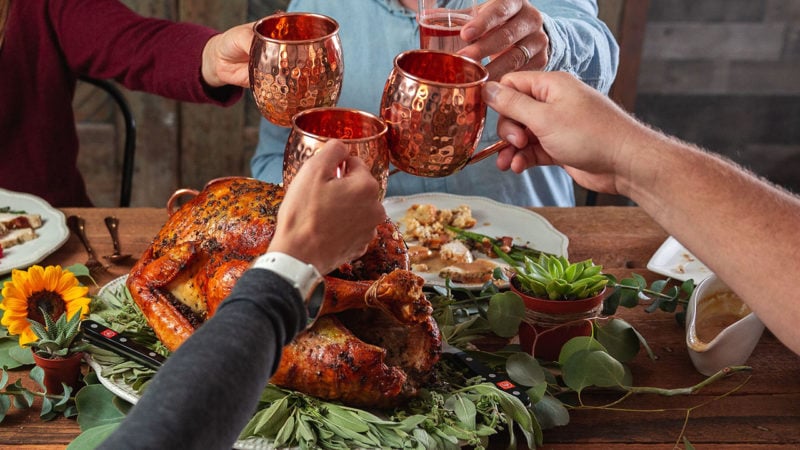Last Updated on November 29, 2019
Thanksgiving is fun, but it’s often reserved for family and maybe a select few family friends. And while most of us absolutely want to celebrate how grateful we are for your family, maybe we’d also like to do the same with your other friends.
If this describes you, hosting your own “Friendsgiving” is a must. This “holiday” is a recent development, but it’s got a classic sentiment at its core: Expressing gratitude for the people you love, and sharing a meal with them to show it.
And while Friendsgiving is essentially the friends-only version of Thanksgiving, it’s got several unique quirks. For one, it’s not usually quite as formal as Thanksgiving. You don’t have to go all-in on making the classic, massive Thanksgiving feast—and then cleaning up the mess left behind.
And, it’s actually best as a potluck, which is always fun.
Below, we detail seven essential tips for hosting your first Friendsgiving. We’ll talk about how to make it a potluck, how to keep it inclusive, and more.
1. Make Friendsgiving a Potluck
Let’s say this now: If you’re already hosting Thanksgiving dinner, we don’t advise making a second, complete Friendsgiving feast. That’s just a recipe for an overwhelmed, frazzled November.
Make the event a potluck instead. Even if you don’t normally prepare Thanksgiving, Friendsgiving is an awesome opportunity to bring friends together and collectively contribute to an unforgettable meal.
As host, you should plan on making the centerpiece turkey (or another feast-worthy roast, more on that later) because nobody should deal with the logistical nightmare of transporting a just-cooked turkey to a party. Let the rest of your friends kick in with their favorite dishes instead.
That way, nobody is overwhelmed, and you can focus on making memories, instead of mashed potatoes for 10.
2. Schedule It Way Earlier in the Month Than You’d Think
Conveniently, Thanksgiving dinner most often falls on, well, Thanksgiving Day. And while not all families have the luxury of a work-free day, a large chunk of the country has the day off.
Friendsgiving, on the other hand, can be a bit trickier to coordinate. Typically, it falls somewhere in November, but there’s no rule beyond that. This is because each of your friends is managing vastly different work schedules, parenting obligations, and other commitments.
So, set the date as far in advance as possible, and coordinate with your friends for the best time for everyone. We’d recommend sending out feelers at least a month in advance so that all of your friends can block it off in their calendars.
3. Who Brings What? Play to Each Other’s Strengths
So, if you’re making the turkey, who is making everything else? Here’s where you should poll your friends on their favorite things to cook.
If one friend is an excellent baker, let them whip up a beautiful dessert. If another cooks up a dreamy mac and cheese, that’s all them.
On the other side of the spectrum, let friends who don’t enjoy cooking (or are otherwise too busy) bring a salad, cheese platter, or loaf of bread and wine.
4. Don’t Stick to the Classics Alone
Here is where Friendsgiving can differ greatly from Thanksgiving. While a classic Thanksgiving meal is a feast to behold, not everyone wants to eat two gigantic feasts (plus leftovers!) in the span of a few weeks.
So, be flexible about your Friendsgiving offerings. Assign friends categories typically found in large meals (potatoes, vegetables, etc.) and let them dream up their favorite side dish.
If your friend wants to whip up a roasted sweet potato side instead of the casserole, let them. If another friend prefers glazed carrots over green bean casserole, that’s all good, too.
Here are a few traditional and unorthodox side dish recipes we’d recommend:
- Gluten-Free Beefy Mac and Cheese
- ButcherBox Sausage and Apple Stuffing
- Bacon and Gruyere Kugel
- Sweet Italian Sausage Succotash
Remember, the same advice about forgoing the classics stands for you, host. If you don’t want to make a turkey, don’t. Here are some recipes for a show-stopping turkey, along with other delicious roasts:
- Thanksgiving Turkey with Apple Cider Brine
- Ribeye Roast
- New York Strip Roast
- Cumin and Orange Pork Butt
- Lemon Herb Roasted Chicken
- One-Pot Beef Brisket with Apricots
5. Don’t Forget the Appetizers
If there’s a delay in preparation or cook time of the turkey, you don’t want guests to grow hangry. Even if everything goes according to plan, it’s nice to snack for the few hours before the feast is served.
Serve up a few appetizers (along with drinks) a few hours before the meal. You can absolutely divvy up appetizer duty among friends, and opt for some easy options, like store-bought cheese and charcuterie, or a veggie tray.
If you’re looking for homemade options, here’s a few we’d suggest:
- Salmon Croquettes with Remoulade
- Bacon Cheeseburger Meatballs
- Seared Scallops with Bacon Lemon Cream Sauce
- Easy Baked Chicken Wings with Yogurt Dip
- Bacon Guacamole
- Tuscan Chicken Dip
6. Be Inclusive – Accommodate Dietary Restrictions
We all have different dietary preferences and restrictions, and it’s no fun when you’ve put all this effort into a meal that somebody can’t eat. It’s, of course, even worse for that person.
So, make it standard practice to ask everyone about dietary restrictions, and make sure everyone who is cooking knows about it. Make sure there are multiple options for everyone to enjoy.
If somebody has an allergy, prepare multiple dishes without the allergen, or omit it entirely depending on the severity of the allergy. If a friend is sticking to a specific diet, like Paleo or keto, whip up this Paleo colcannon in place of mashed potatoes, or these keto caramelized onion meatballs for an appetizer.
7. Stock Up on Containers for Leftovers
You’ve all shared in and contributed to the feast, now you all should get to take it home.
Be sure to stock up on easy containers to send your guests home with leftovers. Whether you opt for disposable or sustainable is up to you—just don’t send off all of your meal prep containers and expect to get them right back.
Divvying up leftovers also ensures your fridge isn’t overflowing, especially with Thanksgiving looming.



